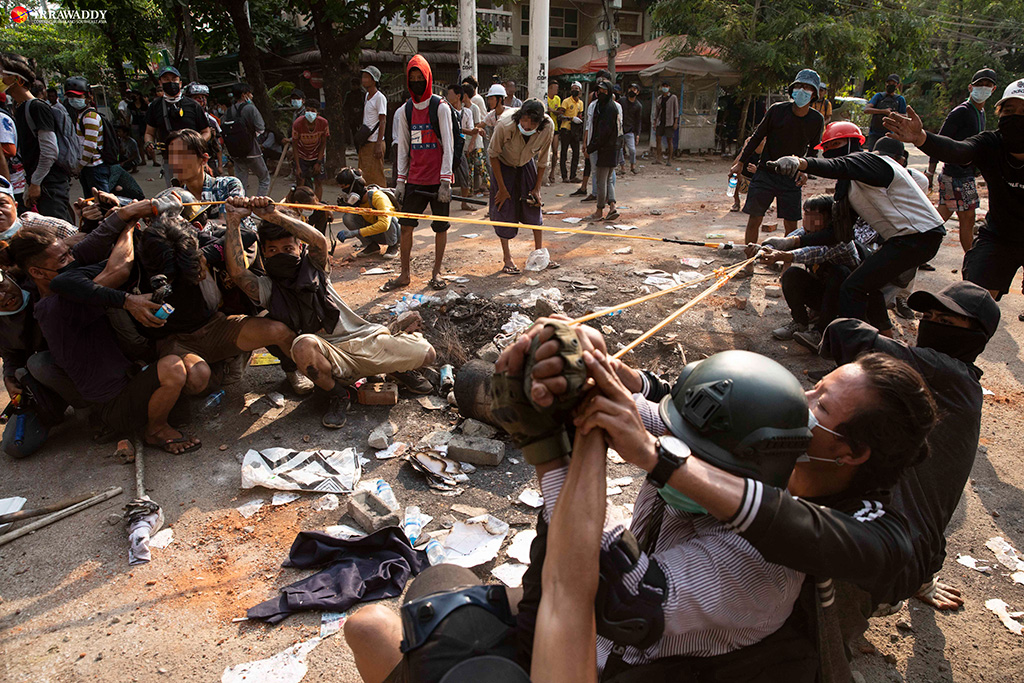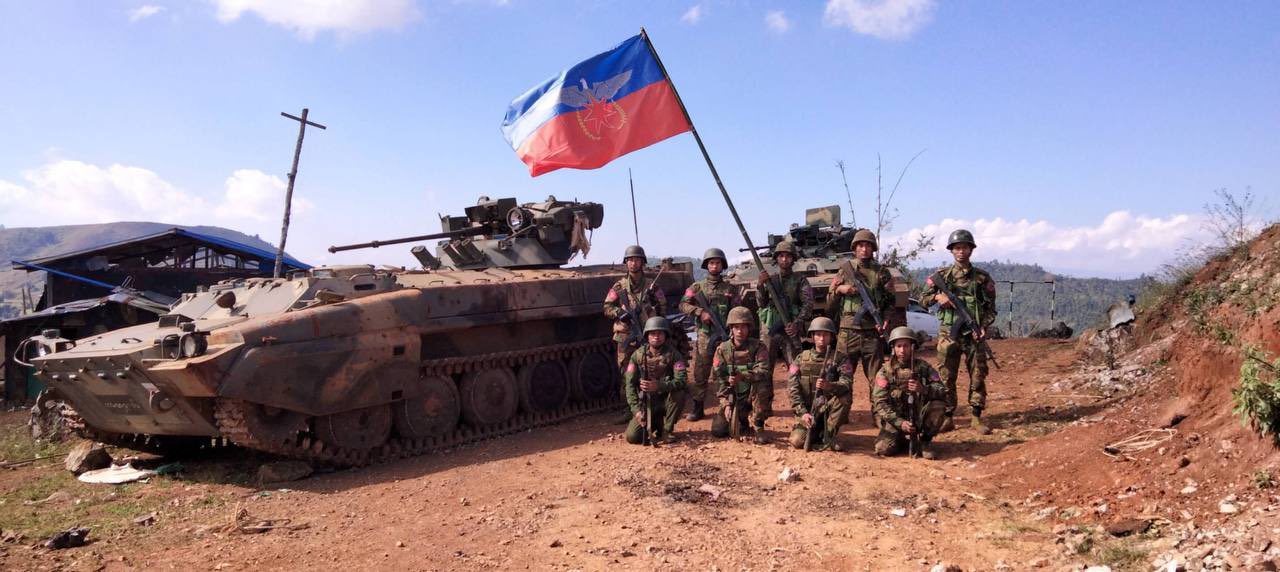Myanmar is in uncharted territory: The country has been in a state of war for almost three years—a war between an illegitimate regime and a defiant people. The nation is bloodied every day, the people are in a state of anguish and the regime is more brutal than ever. It is also, however, the worst time the aggressive junta and its military has experienced since the coup.
Viewed as an “indispensable” institution or “all powerful” military by neighboring countries, their leaders and even some parts of the Western world, despite its long and ugly history of gross human rights violations and cruelties against the country’s entire population, the Myanmar military has now been exposed, both internally and on the battlefield, as a demoralized and broken institution.
This is what we have witnessed over the past two months since Oct. 27, when the Brotherhood Alliance, made up of the Myanmar National Democratic Alliance Army (MNDAA), Ta’ang National Liberation Army (TNLA) and Arakan Army (AA), launched its first coordinated military offensive, Operation 1027, against junta forces in northern Shan State bordering China.
Twenty-three towns and more than 400 junta military bases and outposts have been seized by the Brotherhood Alliance and their allied resistance armies including the Karenni Nationalities Defense Forces and Chin National Front in Shan, Karenni (Kayah), Chin, Rakhine and Kachin states as well as Sagaing and Magwe regions.
But it can’t be hailed as a “triumph” over the junta. These defeats show how wrong the universal, traditional view, held by both analysts and the public, of the Myanmar military was. They have exposed the weakness of the “all powerful” military, though its troops are equipped with tanks, artillery, bigger weapons and jet fighters. Its soldiers, even though they outgun the resistance fighters, have been defeated. Hundreds of soldiers, including officers, have surrendered to the resistance forces without even fighting back.
This has indicated how demoralized the junta troops are and how breakable the military as a whole is. This state of demoralization is true of most of the junta troops, which were previously estimated to number up to 350,000. Since the coup, however, many analysts have reassessed that number as exaggerated and now believe the combat troops don’t number much more than 100,000.
Whatever its strength in terms of weaponry and number of troops, it was not enough to defeat the recent military offensives coordinated by the ethnic armed organizations and People’s Defense Forces. Troop demoralization is one of the key factors in their defeat. Another is public anger against the military for staging the coup, defying their will and the votes they cast in the 2020 election. The defeats also reflect the fact that the military is not supported by the public but, instead, is detested by it. The Myanmar people have stopped calling the military Tatmadaw, which conveys a sense of respect, and now call it Sit-khwe (junta military dog). Without the public’s support, public or political organizations cannot survive.
The recent resistance offensives can be seen as a kind of “testing of the water” against the military. Even the degree of success seen so far is a kind of a “miracle” for the people, as it is unprecedented.
But many observers, including seasoned Myanmar watchers, didn’t think it was possible based on their understanding of the country’s history and the military’s role in it. In their notebooks, such a scenario was unthinkable. No one could have predicted it. But that’s an absolutely different view from the one held by the people of Myanmar, most of whom don’t analyze, but simply believe that the military can be defeated—even though history didn’t seem to be on their side. Such a strong belief or feeling acts as a positive force helping people to keep struggling to achieve their goal. For observers, perhaps, this was not one of the barometers or theoretical factors in their analyses of a situation like Myanmar’s.
From slingshots to drones
The people of Myanmar, especially young people, have proved this belief can lead to success. What we shouldn’t forget is that the origins of the recent military defeats against the junta lie in the makeshift “weapons”—like slingshots, catapults, air guns made from blue plastic pipes, slings, and bamboo arrows, as well as makeshift shields, smoke screens and even firecrackers used to hide from the regime troops—that were improvised by protesters in the early days after the coup. They used them to defend themselves from the junta soldiers who fired at them with live ammunition in Yangon and some other cities. Many of them were killed, but they refused to cower.

Most of those young fighters went on to form People Defense Forces (PDFs) across the country, including in areas controlled by EAOs. Many of the 20 ethnic armies around the country have since stated their political stand in solidarity with the anti-coup movement. They have supported, trained and equipped the PDFs, and have fought the junta troops together with those PDFs for more than two years.
That was the first stage in the path that led to the current coordinated military offensives against the junta military. What we are seeing now is the inevitable consequence after the regime led by Min Aung Hlaing turned Myanmar into a “killing field” by gunning down many peaceful protesters, including innocent children, soon after the coup. So far the regime has killed 4,268 people, arrested more than 25,000 and destroyed more than 77,000 houses. As of August this year, it had carried out 902 air strikes across Myanmar, killing at least 687 civilians, including children, and the attacks are still going on. This is to say nothing of the 2.6 million people who have been forced from their homes since the 2021 coup.
Having endured nearly three years of such systematic killing and destruction targeting the entire population, most Myanmar people are more determined than ever to support the armed resistance against the brutal military.
Many analysts and scholars failed to foresee that the peaceful and colorful protests on the streets in cities in the early months after the coup in February 2021 would evolve into a full-blown armed resistance against the junta’s powerful military. Military leaders and their collaborators looked down on the anti-coup movement, while observers misjudged the people’s resilience and ability to resist.
Junta spokesperson Maj-Gen Zaw Min Tun confided to one reporter off the record that coup maker Min Aung Hlaing and the rest of the generals believed that it would take a year at most to quell all of the various anti-coup protests across the country. Now they have found they were totally wrong. The young people they once looked down on are now defeating them not only on the ground, but also from the air with improvised drones, prompting Min Aung Hlaing to admit that the unmanned aerial vehicles played a major role in the capture of junta bases in northern Shan.
And we shouldn’t overlook the fact that the resistance has reached this stage in a process that has been organic. This armed resistance hasn’t received any support from the international community but has been supported by Myanmar people at home, as well as by diaspora communities across the world. They have donated millions of dollars to all resistance forces, including the parallel Nation Unity Government, since the resistance started. But the international community has mostly just expressed fear that such armed resistance would cause the country to collapse. It couldn’t understand the feelings of the Myanmar people, who are clear about what they want – the bottom line is to end this dictatorship. Since the coup, many protesters, including young students, have expressed feelings like: “We are more afraid of living under the military dictatorship than being killed now.” This sentiment is generally still strong even after nearly three years of resistance.
Anything is possible with this kind of determination among the people and coordination (even limited coordination) with some armed resistance forces. This has been proven in the various ways they have mounted their “revolution” against the junta. All of it, from the current major defeats to the smaller victories against the junta, are the result of the efforts and sacrifices the people of Myanmar have made over the past nearly three years.

At the moment, to get a sense of the real situation, we first must dispense with the idea that the junta is controlling the country and reigning over the people, and that its military is defeating its enemies (the resistance forces) on the front lines. No, that’s no longer the case. We’ve all seen that the truth is the reverse: Over the past nearly three years since the coup the junta has been losing control in governance and politics, over the economy, and also over towns and military positions.
The reality is this: The junta is besieged by the entire population of Myanmar and its military is being attacked by numerous resistance forces from every corner of the country, working together or separately. To be more specific: A handful of hated generals and their collaborators are surrounded by about 55 million people (you can’t exclude housewives and kids, youth and the elderly, minority and majority groups); its military battalions, police and other security forces are surrounded by resistance forces, are on the defensive, surrendering or on the run.
Perhaps the world has failed to understand that the ongoing war in Myanmar was unavoidable, like the fight in World War II to contain the aggression launched by the Axis powers of Nazi Germany, fascist Italy and imperial Japan. It is Min Aung Hlaing and his regime that started this war with their coup in 2021. For the people of Myanmar, this is the war to end all wars—political wars that nullify election results and crackdown on pro-democracy parties, wars of aggression against ethnic forces and greedy wars that monopolize the country’s resources and businesses for the military’s own interest. These are wars that the ruling junta waged in the past, is waging now and will seek to wage in the future.
With a proper understanding of the country’s political culture, the deeper level of the people’s resistance this time to the military, and their determination to keep fighting for a new federal democracy, one cannot only analyze but also sense that this war against the junta will continue, whatever it takes.
No doubt this war will continue into 2024. It’s unlikely we will see something wonderful happen very suddenly. But through the endeavors of the people, we can hope to see this darkest era end soon and to welcome a new dawn that will see the creation of a new nation built on the freedom and federalism, democracy and prosperity, peace and happiness that the Myanmar people have longed for. The justice and truth they have been fighting for shall prevail.
















